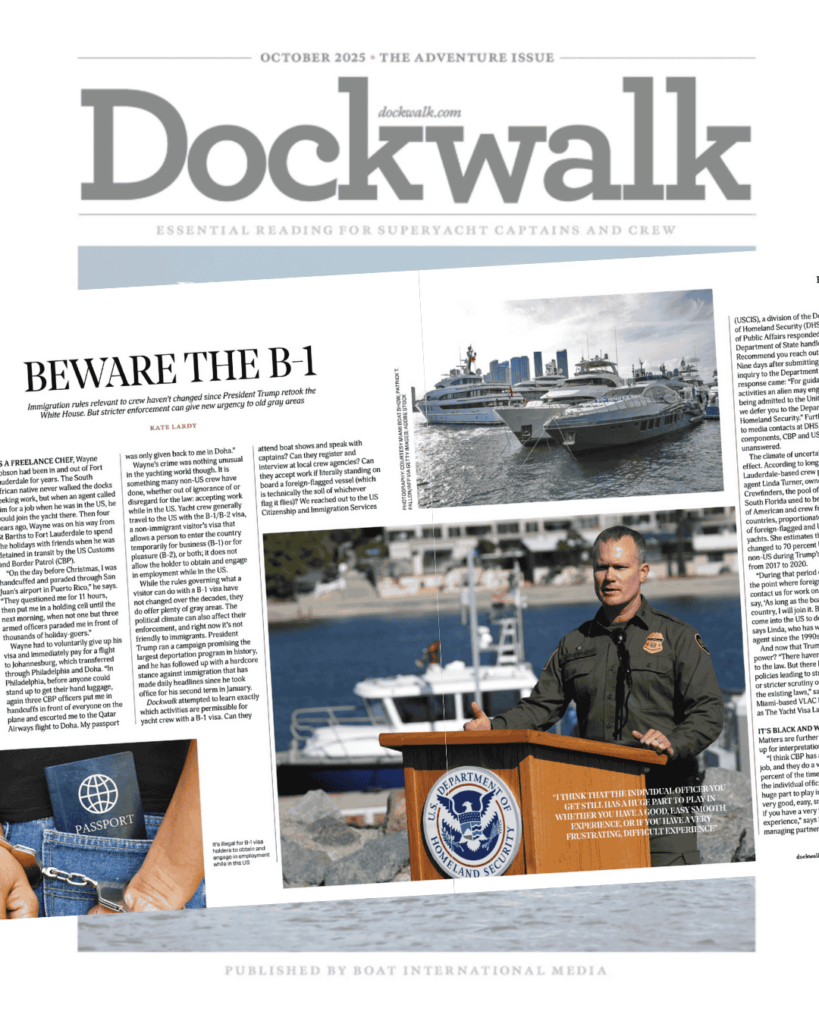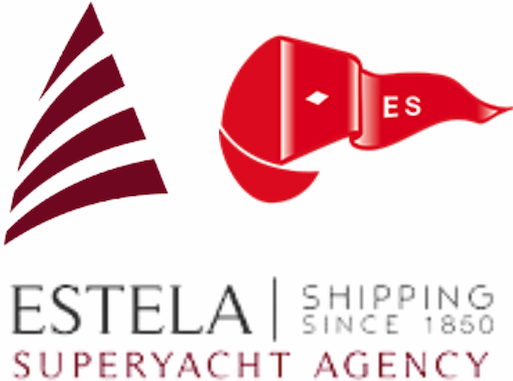
In light of recent reports about the US State Department putting an end to ‘embassy shopping’ and crew having visas revoked, the usual debate about B-1/B-2 visas has been hotter than usual at this time of year.
The Fort Lauderdale Yacht Crew Facebook group lit up this week after we shared an article that appears in the latest edition of Dockwalk magazine.
The article entitled “Beware the B-1” set out to provide definitive answers from US authorities, to address speculation about changes to admittance rules and employment practices for yacht crew.
As the second Trump administration looks to stem immigration and step up deportations of illegal immigrants and visitors, non-American yacht crew are inevitably getting caught out by altered guidance coming from the top.
It’s fair to say that the crackdown is creating a climate of fear and uncertainty that is disrupting the yachting industry.
We reported previously that some crew members with valid US had had their B-1/B-2 visas revoked and were subject to removal orders. In response, more crew and crew agents reported reported similar difficulties, highlighting that these were not isolated cases.
What’s changed?
By the letter of the law, nothing. Though there has doubtless been a shift in the way that laws are being interpreted and applied.
The Dockwalk article’s author set out to obtain hard and fast answers from various US agencies and found herself sent from pillar to post.
There have always been grey areas between the law and its interpretation, while enforcement can vary depending on offices and even on the individual doing the scrutinising. That’s not only the case in South Florida, of course. We are reminded of the trio of CBP officers presenting at last November’s FLIBS show, who caused consternation by issuing incorrect guidance about working in dry dock.
The definition of “US soil”?
The core legal issue is that travelling on a B-1/B-2 visa explicitly forbids accepting work while in the United States. However, whether seeking or accepting a job while physically on a foreign-flagged yacht in US waters is considered ‘on US soil’ is a perennial grey area.
Anecdotal reports suggest that the lack of clear guidance is deterring foreign crew from seeking work in the US altogether. One South Florida recruiter reports a shift in the US-to-foreign crew ratio from 50/50 to 70/30 since Trump’s first term in office, citing a hostile political atmosphere. Many foreign crew were declining to take up US-based positions if the vessel was in US waters, she added.
New interpretations
For close guidance on the rules, we refer you to our comprehensive guide The A to Z of B1/B2 Visas.
The main guidelines to follow strictly are unchanged:
- Demonstrate permanent ties to your home country during visa applications
- Be consistent in visa documentation
- Understand exactly who is employing you
- Ensure that departure timings align with vessel movements
Our colleague on the ground and fellow AYSS member, Deb Radtke, of American Yacht Agents based in South Florida, provides additional guidance on what Customs & Border Protection officers are clamping down on:
- Be prepared for phone searches at borders (technically permitted only with the handset in aeroplane mode, but non-cooperation can result in denial of entry)
- Joining vessels in the US but departing before the vessel leaves is now viewed as potential “domestic employment.”
- Prepare for the question of where you live (legally) before applying for a visa or entering the US
- Be able to give the name of your legal employer upon arrival; carry a short letter from the employer outlining employment and payroll details clearly
- Don’t spend too much time cumulatively in the US; avoid jobs on US-based boats that spend more than six months a year in FL. Since 2019 foreign crew have been permitted to work on US-flagged vessels (on a foreign payroll), but the yacht can’t be based in the US. Working on a yacht that spends more than half the year in the US can be viewed as a ‘domestic employment’ violation. If you got into yachting to travel, get a job on a boat that travels.
- If arriving in Ft. Lauderdale for FLIBS in October, avoid flying out until January to join a vessel in the Caribbean. It can give the appearance of having worked illegally.
Radtke adds that while enforcement is stricter across the three main South Florida ports, officers at West Palm Beach (WPB) are particularly proactive in their scrutiny. Admission has always been at immigration officers’ discretion, of course.
It is important to periodically check your online I-94 entry record, to monitor how much time you have remaining on each visa. The incorrect visa may have been activated (stamped) upon entry to the country. In this case, visit the CBP Deferred Inspection Office, where they can rectify records retrospectively by bringing supporting paperwork. Best of all, the captain should accompany the crew member.
Seek advice
In terms of applying for a B1/B2, not a great deal has changed, aside from where applicants are permitted to apply. From September 2025, applicants may only apply in their country of nationality or, if different, from their legal residence. Should you be unable to prove where you live, if not in your home country, chances of being declined are heightened.
You do not require an agent to handle your visa application. Some yacht agents claim “100% success” in US visa applications, which is abject nonsense. As long as you follow the guidance to the letter, you will most likely be successful. All an agent can do is ensure that all your paperwork is present and correct, but the application is for you to submit. Your money is better spent on local agency support when entering the US and joining a boat.
If in doubt, ask an agent. They know the way the wind is blowing and the pitfalls to look out for. Don’t ask questions of the Facebook hivemind, which invariably draws well-intended but often incorrect or incomplete information. Don’t ask ChatGPT either; it can direct you to third-party sources of information, of course, but it won’t be able to take into account your own particular travel history and individual circumstances.
Our complete guide to B1/B2 visas is here:
https://estelashipping.es/the-a-to-z-of-b1-b2-visas/
Related articles:
End of ‘embassy shopping’: US restricts where yacht crew can apply for a B1/B2 visa
US B1/B2 visa revocations affecting yacht crew
Schengen EES rollout in October: What yacht crew need to know
